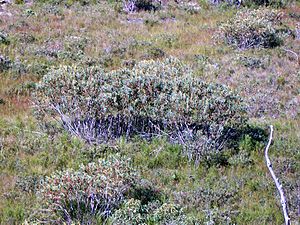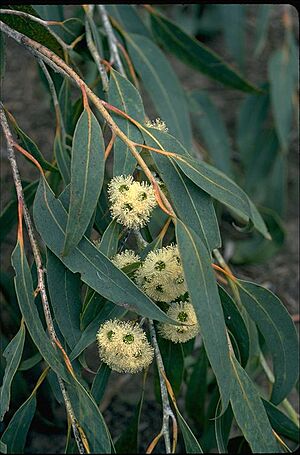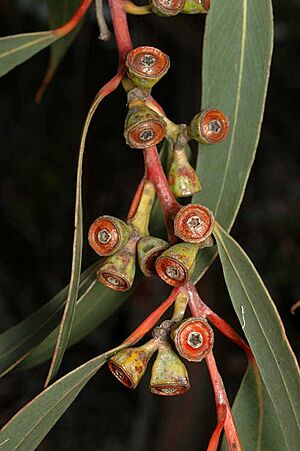Yellow top mallee ash facts for kids
Quick facts for kids Yellow top mallee ash |
|
|---|---|
 |
|
| Eucalyptus luehmanniana at Ku-ring-gai Chase National Park | |
| Scientific classification | |
| Genus: |
Eucalyptus
|
| Species: |
luehmanniana
|
| Synonyms | |
|
|
The Eucalyptus luehmanniana, also known as the yellow top mallee ash, is a special type of mallee tree. It only grows in a small part of New South Wales, Australia. This plant has smooth, white bark and leaves shaped like spears. Its flowers are white, and its fruit looks like a cup or a barrel. You can find it growing in rocky, poor soil near Sydney.
Contents
What Does the Yellow Top Mallee Ash Look Like?
The yellow top mallee ash is a type of mallee plant. This means it's a shrub or small tree with many stems growing from a woody base called a Lignotuber. It usually grows to be about 6 to 7 meters (about 20 to 23 feet) tall.
Bark and Leaves
This plant has smooth bark that can be white or brown. It peels off in long strips, like ribbons. Young plants have stems that are almost square. Their leaves are shiny green, oval to wide and spear-shaped. These young leaves are about 7 to 17.5 centimeters (about 3 to 7 inches) long and 3 to 7.5 centimeters (about 1 to 3 inches) wide. They don't have a stalk, meaning they attach directly to the stem.
Older leaves are also shiny green on both sides. They are spear-shaped or slightly curved, about 10 to 20 centimeters (about 4 to 8 inches) long and 2 to 4.5 centimeters (about 1 to 2 inches) wide. These leaves have a stalk, called a petiole, which is about 1.7 to 4 centimeters (about 0.7 to 1.6 inches) long.
Flowers and Fruit
The flower buds grow in groups of 7 to 11 or more. They are found where the leaves meet the stem. Each group of buds sits on a flat, unbranched stalk called a peduncle, which is about 1.5 to 2.5 centimeters (about 0.6 to 1 inch) long. Each individual bud has its own small stalk, called a pedicel, about 0.3 to 1.1 centimeters (about 0.1 to 0.4 inches) long.
When the buds are ready, they are shaped like a club or a diamond. They are about 0.6 to 1 centimeter (about 0.2 to 0.4 inches) long and 0.4 to 0.7 centimeters (about 0.16 to 0.28 inches) wide. The top part of the bud, called the operculum (like a cap), is shaped like a cone and is about the same size as the base of the flower.
This plant flowers between June and December, and its flowers are white. After flowering, it produces a woody fruit. This fruit is a capsule that can be shaped like a cup, an urn, or a barrel. It's about 0.8 to 1.3 centimeters (about 0.3 to 0.5 inches) long and 0.9 to 1.2 centimeters (about 0.35 to 0.47 inches) wide. The parts that open to release seeds are close to the rim of the fruit.
How It Got Its Name
The yellow top mallee ash was first officially described in 1878 by a scientist named Ferdinand von Mueller. He wrote about it in his book Fragmenta phytographiae Australiae. The first sample of the plant used for its description was collected by William Kirton. He found it in sandy, rocky ground about eight miles north of Bulli, at a height of 2000 feet.
The plant's scientific name, luehmanniana, was given to honor Johann George Luehmann. He was an assistant to Ferdinand von Mueller at the Melbourne Herbarium, a place where plant samples are kept and studied.
Where Does It Grow?
The yellow top mallee ash grows in a type of plant community called mallee heath. It prefers shallow soils that come from sandstone. You can find it on the coastal plateau in the Sydney area, specifically between the Hawkesbury River and Bulli. Even though it only grows in a small area, there are many of these plants in the places where they do live.
A Fun Fact About the Yellow Top Mallee Ash
Did you know that the fruit of this eucalyptus plant was shown on the very first five dollar note? It was pictured next to a drawing of Joseph Banks, a famous botanist who traveled with Captain Cook.




